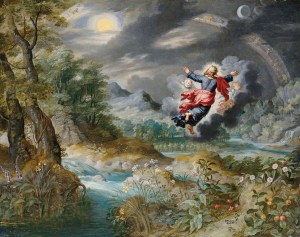We support our Publishers and Content Creators. You can view this story on their website by CLICKING HERE.
“Women of the Catholic Imagination” highlights Catholic novelists whose perspective is expressly female, not because they wrote about women’s issues, but because the writers are women. The stories are not about Catholic things, but are Catholic because the authors have a Catholic world view, which can’t help but permeate their works.
It never ceases to amaze me how insatiable is our appetite for words. We write and read, speak and listen. Books, news, movies, gossip, podcasts, poetry, lectures, plays, songs, stories, jokes, essays, and, best of all, conversation. Across the kitchen table, across great distances, across time. We must communicate with words. “It is not good that the man should be alone”, so woman was created and human conversation became possible – and necessary.
People have been writing for thousands of years. You’d think everything that could be said has been said by now. But that never will be because each person brings something new to say about a matter. One’s commentary is uniquely his—or hers in the case of this fine volume. And should it be any surprise that man, made in God’s image, should resemble his maker in this creative way? Like all of creation, we were spoken into existence, then God gave His commentary, declaring man to be good.
And so it is that I write a commentary on this book containing twelve essays, which comment on a dozen Catholic women, who, in turn, present to their readers their commentary on truths best conveyed through stories.
Women of the Catholic Imagination: Twelve Inspired Novelists You Should Know highlights Catholic novelists whose perspective is expressly female, not because they wrote about women’s issues, but because the writers are women. The stories are not about Catholic things, but are Catholic because the authors have a Catholic world view, which can’t help but permeate their works. The works of the twelve featured novelists span the time frame from the late nineteenth century with Josephine Ward (mother of the perhaps better-known publisher, Maisie Ward) through early in this century with Donna Tartt. Within this time frame the authors covered include Sigrid Undset, Caryll Houselander, Gertrud von le Fort, Flannery O’Connor, Caroline Gordon, Rumer Godden, Alice Thomas Ellis, Muriel Spark, Toni Morrison, and Alice McDermott. Each essay is contributed by a different writer. All are sandwiched between an introduction by the editor of the book, Haley Stewart, and a conclusion written by Natalia Sanmartin Fenollera, author of the award winning The Awakening of Miss Primm (2014). Altogether, it is a very pleasing volume, even down to the feel of the quality paper and the cover art.
The stated criteria for inclusion as Catholic novelists are two: that the author was a baptized Catholic and, more abstract, that their novels are “infused with a sacramental view that evangelizes the reader with beauty”. The latter, being a subjective measure, sparks much of the thought contained in the essays and is what makes the collection so interesting. Perhaps the first requirement should spark discussion as well, as it becomes clear in reading about the lives of these diverse women, that their level of devotion and practice was also widely varied. What is clearly not a requirement for inclusion in this collection is a holy life or a pious or devout practice of the Faith.
There seems to be one more, unmentioned criterion for inclusion: she hit the big time. All of the authors included were widely known and many are recipients of major awards for their works (Nobel Prize, Pulitzer Prize, National Book Award, etc.), and all were or are widely known in their time. This factor may have limited the field of included writers in the more recent years, as there is a healthy number of small Catholic publishers today that publish the works of fine Catholic writers likely to live the Faith with fervor and devotion. The downside to this niche publishing corner is that these works are virtually invisible and perhaps anathema to the mainstream secular world that confers major writing awards. Fiorella de Maria comes to mind as an overlooked Catholic, woman novelist.
Delving into the book itself, we meet old and new friends. I was previously familiar with about half of the writers and good friends with fewer. Some of the essays present a balanced treatment of the authors’ personal biography with an overview of their writing. Others focus almost entirely on their works, with a deep dive into one particular novel. Some are more academic in tone than others, but all are accessible and will broaden the reader’s appreciation of each author’s works as well as of fiction’s ability to bring comprehension to universal human experience through the medium of storytelling.
That the dozen authors explored in Women of the Catholic Imagination are ordered chronologically adds a rich historical perspective on literary, social, and Catholic culture of the century and a half covered in these commentaries. For instance, the reader begins to see from details of the authors’ lives and works, though it is not highlighted per se in the essays, the deep traumatic impact of both world wars, not fully appreciated by those who did not live through these times. Suffering is part of the human condition that brings about more contemplation than any other aspect of life.
In the chapter on Alice Thomas Ellis (my favorite in the book), Bonnie Lander Johnson makes note of this important feature of Catholic writers that distinguishes their work from that of others. “[Virginia] Woolf asked, ‘What conditions are necessary for the creation of works of art?’ and offered her own answer: ‘freedom.’ Ellis’ answer, however was ‘suffering.’” Lander contrasts the two women, one self-centered and striving to be an Artist, the other whose life was lived at the service of others as a wife and mother. Her column for The Spectator was called “Home Life” and she became a sought-after editor. Ellis claimed her involvement in publishing was only really to aid her husband, whose career it was. Her writing, stories and editing centered largely around the kitchen table, where her literary work was fit in around the vocationally important work of cooking meals, feeding children, writing shopping lists, and having tea and conversation with friends.
It is always a bit disappointing to me to read about Flannery O’Connor and her weird, disturbing (but oh, so funny) stories and not have it emphasized how thoroughly and devoutly Catholic she was. Maybe it’s because her devout faith is a given or maybe because when discussed from a literary point of view, the trick is to explain how her works reflect her faith, a reflection that is not obvious to most first-time readers. O’Connor wasn’t a writer who was Catholic, but a Catholic, who was a writer. Angela Alaimo O’Donnell’s essay does a fine job of explicating a good array of O’Connor’s works as Catholic. If it leaves you hungry for a better view of the author’s interior life, you may find satisfaction in Lorraine Murray’s biography, The Abbess of Andalusia: Flannery O’Connor’s Spiritual Journey.
I must confess a complete unfamiliarity with many of the more recent authors treated in this collection. It is fascinating to read analyses of their works and see what must surely have been the influence of O’Connor’s technique of shocking the reader with violence. In fact, O’Connor’s name appears in every subsequent essay, either in the text or footnotes. O’Donnell offers us O’Connor’s explanation: “I have found that violence is strangely capable of returning my characters to reality and preparing them to accept their moment of grace. Their heads are so hard that almost nothing else will do the work.”
Gone are the times, it seems, when gentle nuance in novels conveys truth and converts characters—and readers. Not everyone can be Jane Austen! But, then, in Austen’s day, the culture at large still found a moral vocabulary comprehensible. And so today we have works of award-winning literary shock treatment for a time of moral insanity. Will it work? Time will tell.
Call me a stickler, but I find myself quibbling a bit with the epithet “Catholic” being attached to those who have ceased to practice the Faith. While it is not always clear in the essays, not a few of these women authors seem to have lapsed in their adherence to the precepts and or moral doctrine of the Catholic Church. This does not, of course, disqualify their works from expressing Catholic, sacramental, or incarnational realities. On the contrary, once one has been steeped with the teabag of the Catholic Faith, the result will be tea, even if a weak version. To make a really good pot of tea, however, one must leave the leaves in the pot to achieve strong, full-flavored perfection.
I would even argue that within every great story ever written one will discern the same truths that are here recognized as Catholic because the Catholic Church is the repository for Truth and the source of salvation for which every human soul is thirsting. The Church is the most clear and full avenue of Reason and Revelation. It contains the Truth that our intellects were designed to wrap around. Any real truth to be found is contained within this Faith, even if found partially elsewhere. All great storytelling is great because it conveys the greatest truth: conversion to truth. So, any novel that earns the designation “great” could be analyzed and proclaimed “Catholic” in some sense.
Nevertheless, these women writers ought to be recognized, their works hailed, and these essays read because they open our eyes to a deeper vision of literature and the converting truth it contains. This collection leads me to considering heading to my local library to seek previously unknown novelists and make their acquaintance. I would be interested in a future volume of lesser-known Catholic women novelists who are fully devout and whose works will never therefore qualify for the New York Times Bestsellers List. I wonder if Word on Fire will indulge me!
Susannah Pearce is a wife and mother whose essays and articles have been published in The Epoch Times, The Imaginative Conservative and Aleteia.
The Imaginative Conservative applies the principle of appreciation to the discussion of culture and politics—we approach dialogue with magnanimity rather than with mere civility. Will you help us remain a refreshing oasis in the increasingly contentious arena of modern discourse? Please consider donating now.
The featured image is “A Girl Reading” (1828) by Gustav Adolph Henning.

 Conservative
Conservative  Search
Search Trending
Trending Current News
Current News 





